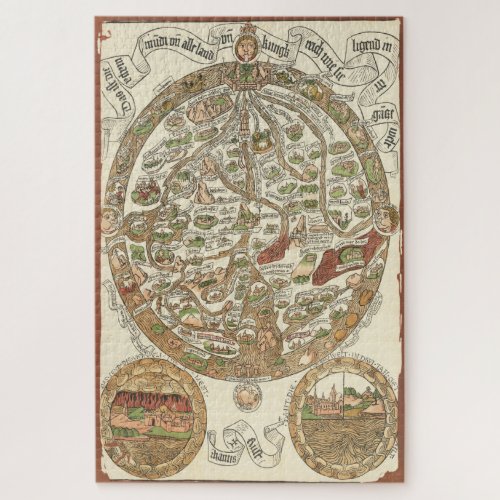1480 Woodcut World Map Jigsaw Puzzle



Hanns Rust's world map was a separately published map, published circa 1480. The map is oriented east at the top and shows the then four principal rivers of the world (Ganges, Phison, Indus, and the Nile) flowing from Paradise at the top of the map. Jerusalem is at the center. Europe, Asia, and Africa are named for Noah's three sons-Ham, Shem, and Japeth-with the map ringed by twelve classical wind heads. Similar to other woodblock maps of this period, the map employs circular symbols showing castles and buildings. Lodged in the border, which is actually a world ocean that rings the continents, are islands (including England), rocks, and ships. This ring represents the edge of the known world and is populated with monsters and strange scenes. Below the map is a smaller T-O model of the world (lower right) which represents the tripartite division of town, country, and sea. In the lower-left is a model of the four elements (air, water, fire, and earth). It was meant for general consumption, as it is written in colloquial German-the first map to be printed in a vernacular language. The translation of the title is impressive in scope. It reads, "This is the mappa mundi of all the lands and kingdoms which there are in the whole world." Rust's map is in the tradition of the mappa mundi, world maps that combined Biblical geography with the experiences of travelers and which represent a broader change in European mapping practices. Adam and Eve are in Paradise, which was always positioned at the top, or the Far East, of these round maps. Medieval T-O projections usually portray Asia at the top of the world, with Europe and Africa splitting the bottom half. The rivers intersect with the Mediterranean, which placed Jerusalem at the geographic center of the world. The Holy City can be seen clearly at the center of this map. In the late-Medieval period, mapmakers were inserting more and more secular details into their projections. These more complex yet still religiously-oriented manuscripts are the famous mappa mundi mentioned earlier. The most famous example of these is in Hereford Cathedral. Despite details of real places, the mappa mundi are more allegorical than geographical, meant to locate the reader within a spiritual and political system more than in a physical space. This holds true in this example, as Flanders is in the Mediterranean on this map, not on mainland Europe, and Rome is located east of both Venice and Greece. This map was printed just at the dawn of a period of increased period of map consciousness, that is an increase in the knowledge and use of maps in everyday situations by a broader portion of the population. The rise in map consciousness developed between roughly 1450 and 1750 for a variety of reasons. First, the cultural movement of the Renaissance encouraged interest in the wider world, as seen in the vogue for elaborately printed geographic tomes full of descriptions and, increasingly, maps. Scholars placed more emphasis on first-hand observation, as well as began to question certain medieval authorities in light of the rediscovery of ancient texts. For mapmaking and geography, the most important of these ancient volumes would be Ptolemy's Geographia, first printed with maps in 1477. Ptolemy's rediscovery points to another development, the printing press. Although manuscript maps continued to be popular as elite commodities, mass-produced maps could reach a wider audience for the first time, as this map attests. These developments spurred a departure from the dependence on scholasticism of the late-Medieval period, as well as marked a realization that the world as early modern Europeans knew it no longer fit into the mold recorded by Medieval scholars and religious experts.


